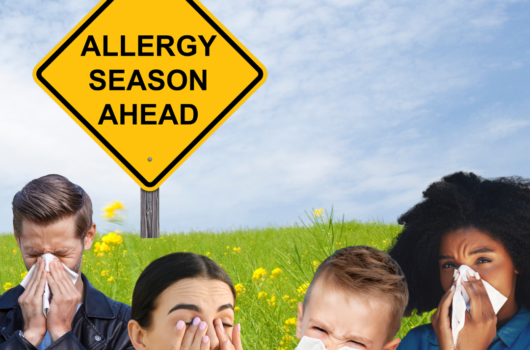‘Tis the Allergy Season!

How Food Choices Can Trigger or Help Seasonal Allergies
Did you know that histamine is a chemical that your immune system releases to send messages between different cells such as triggering an allergic response. Your cells produce histamine as a response to allergy triggers. Histamines act like bouncers at a club to help your body get rid of something that’s bothering you. It is an important part of your allergic response. Histamines start the process that hustles those allergens out of your body or off your skin. They can make you sneeze, tear up or itch. Your body has good intentions to respond to the threat of allergens, but its overreaction is what gives you all those allergy symptoms. People try to stop the symptoms with antihistamine medications to treat symptoms. Histamine can cause an inflammatory rainstorm, leading to an allergic reaction.
Did you know that foods have varying amounts of histamine in them, known as histamine rich foods. Some foods are lower in histamines themselves, but they can cause a release of histamine in your body which can lead to worse symptoms, known as histamine triggering foods.
Age and storing can also affect a food’s histamine level. Some foods may be naturally low in histamine but as they age or ripen, especially those with higher protein content (leftover beef), the amount of histamine rises. Eating your food fresh as opposed to leftovers and stored for a long time can also lessen histamine exposure.
You can choose to eat a low histamine diet by paying attention to what foods are making you symptomatic and eat less of those foods.
The goal of a low histamine diet is not to fully eliminate the food, which would be very difficult, but to pay attention to what foods are triggering symptoms, and instead choose foods that contain lower levels of histamine whenever possible. Tolerance varies from person to person of different foods, so keep a food log of when you consume these higher histamine containing foods to make some connections to how your body responds.
Histamine Rich Foods
- Fermented foods and beverages: sauerkraut, vinegar, soy sauce, kefir, yogurt, kimchi, kombucha
- Alcohol, especially beer and wine
- Vinegar containing foods: pickles, mayonnaise, olives
- Processed or Cured Meats: bacon, salami, pepperoni, lunch meats, hot dogs, canned meat, jerky
- Soured Foods: sour cream, buttermilk, sourdough bread
- Soy and soy products: soy sauce, soybeans, soy lecithin, tofu
- Dried Fruits: apricots, prunes, dates, figs, raisins
- Most Citrus Fruits
- Aged cheese like parmesan, blue cheese, brie
- Nuts: Walnuts, cashews, peanuts
- Wheat
- Vegetables: avocados, eggplant, spinach, and tomatoes, squash
- Smoked fish and certain species of fish: mackerel, tuna, mahi-mahi, anchovies, sardines (especially canned fish)
- Leftovers that have not been frozen
Histamine Releasing Foods
- Alcohol
- Avocados
- Bananas
- Chocolate
- Cow’s milk
- Nuts: walnuts, cashews, peanuts
- Pineapple
- Shellfish
- Strawberries
- Tomatoes
- Many artificial preservatives and dyes
Foods Low in Histamines
- Gluten free grains like amaranth, buckwheat, millet, rice, quinoa
- Fresh meat that has not been aged
- Salmon – fresh or flash frozen within 30 minutes of catch
- Non citrus fruits like apples, blueberries, mangoes, peaches, pomegranates
- Nondairy milk like almond, coconut, hemp
- Olive oil
- Coconut oil
- Almonds
- Potatoes
- Flax
- Chia
- Dairy sources lower in histamine: butter, ghee, ricotta, mozzarella, and other soft cheese that have not been aged or fermented
The fresher the better when it comes to histamine levels in food. The goal is to try to avoid processed foods.
